The paradiddle is the most versatile rudiment pattern for drum set. This pattern has spawned hundreds of variations, and it’s been used in every genre of music imaginable. Much of time it’s not even recognizable to the ear, but to a drummer’s muscle memory it is unforgettable.
Here we take a look at some lessons from Drum! over the year that use the single paradiddle in different ways, from it’s more basic form to mutations that only a seasoned drummer would recognize (or care about).
Unlock The Magic Of The Paradiddle With These 5 Lessons
1. Praise The Paradiddle
Think about this: Millions of books, containing untold numbers of words expressing countless facts, opinions, and stories, are all created entirely using just the 26 letters of the alphabet. It’s really rather amazing.
Now think about all the great drummers you’ve heard playing everything from rock to jazz to hip-hop to metal. All that drumming is created using only five basic elements—kind of like the alphabet for drums. These basic elements are single strokes, double strokes, accents, flams, and buzz strokes.
Enter the paradiddle, one of the 40 internationally recognized drum rudiments. I know, right now you may be saying, “Rudiments?! Nooooooo!” But think about it, paraddidles contain a neat little combination of the three most common and basic elements of drumming on each hand: a single stroke, a double stroke, and an accent. And they treat both hands equally in that they constantly alternate from right to left lead. This is great vocabulary for your drumming arsenal.
Ex. 1 shows the basic paradiddle family: the single, double, and triple. Learn these first and you’ll immediately reap the benefits of an increased hand vocabulary. Start slow and go for rhythmic consistency and dynamic contrast between the accent and the rest of the strokes.
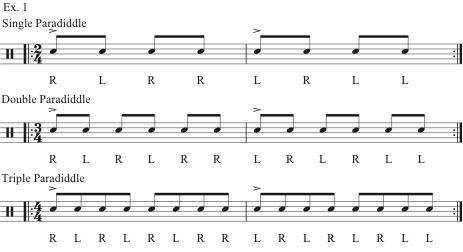
Ex. 2 is a transcription of an excerpt from Buddy Holly’s 1957 hit “Peggy Sue.” Drummer Jerry Allison plays single paradiddles throughout that song only varying the sound by moving from snare to toms. Learning this pattern is a great way to start moving the paradiddle around the kit for fills and soloing.
To help you move your paradiddle vocabulary around the drums in even more interesting ways, Exs. 3–5 contain exercises that move each of the three basic elements of the paradiddle around the drum set. First, the accents are played on the toms with the rest of the notes played on the snare. Then the doubles are moved to the toms. And finally, we move the unaccented single strokes to the toms.
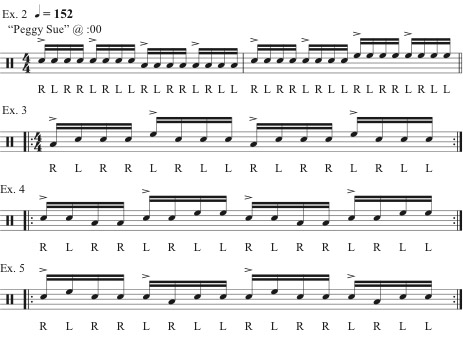
In the chorus of the 1994 tune “Vasoline” by Stone Temple Pilots, drummer Eric Kretz plays the paradiddle pattern orchestrated between the snare and bass drum, as you can see in Ex. 6. The result is a strong and driving groove. Exs. 7–10 take that snare/bass orchestration of the single paradiddle and move it through the inversions of the paradiddle. By inversions I mean that the pattern shifts forward one eighth-note on each example.
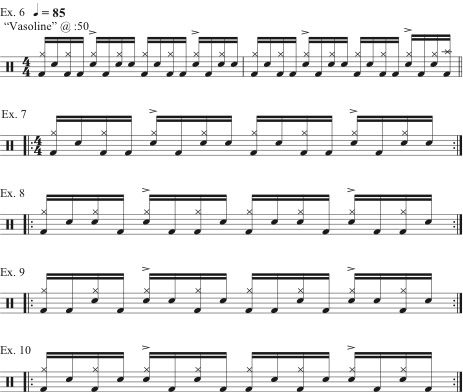
— WALLY SCHNALLE
2. Diddle In The Middle
Have you ever tried squeezing as much as possible from one book exercise? Though any of George Lawrence Stone’s patterns from Stick Control can be expanded upon, we’re going to focus on just one sticking for all of these exercises to make it easier to understand how the basic idea is being revoiced, stretched, and morphed.
The sticking is #6 from page five of Stick Control, a paradiddle inversion of RLLR LRRL (Ex. 1) that lends itself to both grooves and fills. It has been used inventively by great drummers like Steve Gadd. It is sometimes referred to as an “inward paradiddle” or the “diddle in the middle” variation because the double strokes occur in the middle of the pattern.
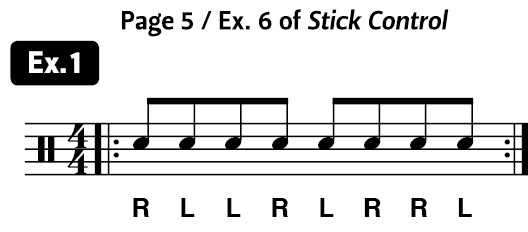
Ex. 7 adds an accent and shifts it later by one sixteenth-note every two beats throughout the pattern. This is harder than it looks.

Adding your feet beneath our pattern will create three- and four-way independence patterns that can really test your grit. Luckily, Ex. 8 isn’t complicated—simply play quarter notes under the snare pattern. Playing different kick patterns under Stone’s stickings can help you develop freedom and independence with Latin rhythms like samba (Ex. 9) and baion (Ex. 10).

— BRAD SCHLUETER
3. Paradiddles From Mars
Here we’ve got some paradiddles like you’ve never seen them before. These are paradiddles played as an ordinary sticking, then flipped on their heads. This exercise is going to develop both hands, and make sure your weak hand burns.
Learning to play it on the kit will really help keep it fun and entertaining. Make sure to hit your toms hard in Ex. 5 as we begin moving around the kit. Each drum has its own personality and the toms need a little more love than the cymbals or snare.

— AARON GILLESPIE
4. Paradiddle Transition And Accent Warmup In 7
For this warmup, I’d like to share some paradiddle transitions and accent exercises in a 7/8 meter. Practicing these exercises will help you to expand your sense of time and your feel for this meter, allowing you to achieve a greater flexibility within 7/8.
In general, this warmup is written to move between the basic exercise (Ex. 1) and Ex. 2-5. You can play each exercise for two bars before switching forward or backward. The subdivision in each exercise is notated as sixteenth-note triplets. Each fifth stroke in the 7/8 meter is played as an accent, while the sticking changes with each exercise.

In Ex. 2, each accented note is followed by double strokes. There are paradiddles within the groups of five notes. The sticking in Ex. 3 is a double paradiddle with accents occurring every five notes, with a turnaround on beat 7. Play Ex. 4 with a paradiddle-diddle sticking.
Finally, Ex. 5 is made up of ten sets of double strokes that move through the accents on every fifth note, with a single-stroke on the ah of beat 7, which leads to a paradiddle sticking through the repeat.
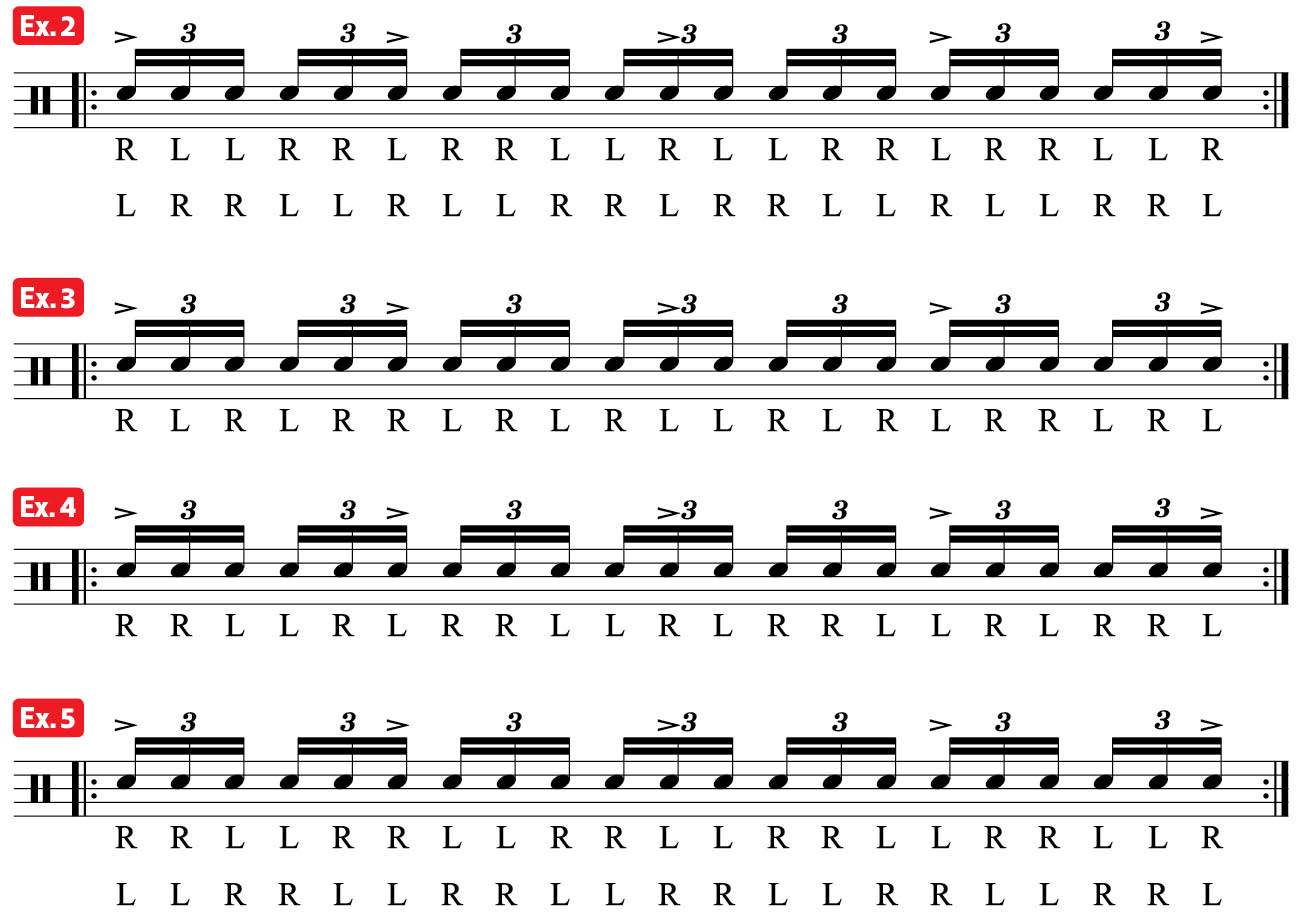
To make yourself more comfortable with Ex. 2-5, start by playing each of them separately and slowly, and play each of them in a loop at first. Setting a metronome to keep time in eighth-notes can be very helpful in memorizing and internalizing the feel for the stickings and accents.
—ANIKA NILLES
5. Bruford’s Use Of Paradiddles
For Bill Bruford, and many others, the paradiddle and its permutations provide a sort of vocabulary of stickings that allow us to explore more complex rhythmic territory. (For example, the handy RLRLRRL and RLRLRLL stickings help you to play in 7/4 by allowing you to begin each new phrase on the right hand.)
Bruford has been able to exploit the endless usefulness of figures like these to a high degree in much of his playing, providing the seed for some of his most celebrated material.
Exs. 5–7 below are all taken from three different performances of the fusion-y 9/8 workout “Beelzebub.” The first is the original studio recording from his 1978 solo debut, Feels Good To Me, the second taken from the Earthworks rendition heard on the Magna Carta label’s Drum Nation Vol. One (2004), and the third comes from a Bruford clinic at Mohawk College in Hamilton, Ontario in 2006. Notice how he uses a distinctly different pattern for each yet relies heavily on paradiddles for all three.
Bruford is also particularly fond of the paradiddle-diddle. To this day, the entirety of Yes’ “Heart Of The Sunrise” remains perhaps the greatest recorded document of one man’s ability to creatively and musically incorporate this rudiment into a piece of music. The passages in Ex. 8 are taken from this masterpiece. Similarly orchestrated figures are plentiful in the King Crimson song “Easy Money” from Larks’ Tongues In Aspic (Ex. 9).
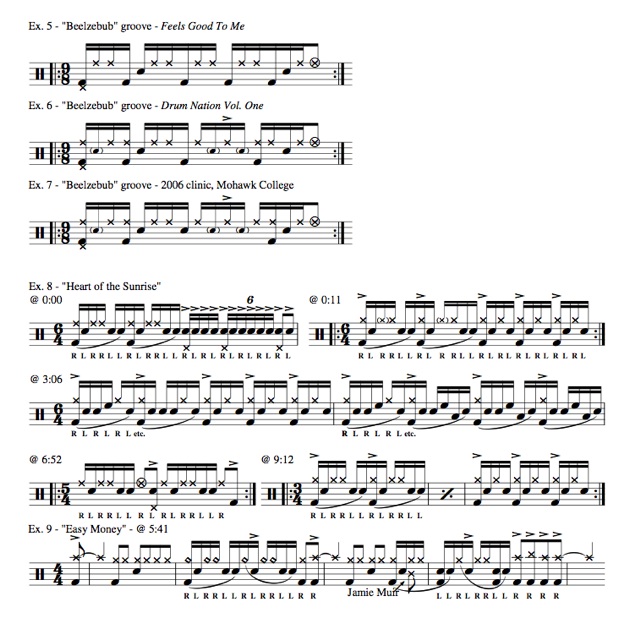
— JOHN NATELLI
